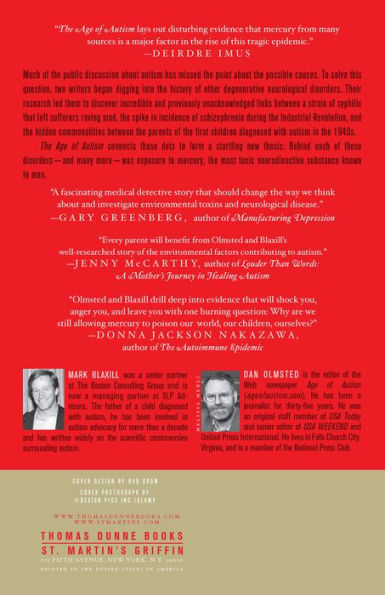Read an Excerpt
We believe that autism was newly discovered in the 1930s for the simple reason that it was new. The organic chemicals industry that grew out of chemical warfare research during World War I led to new commercial uses for mercury, including the introduction of an extraordinarily toxic compound made from ethylmercury. This, our research suggests, led directly to the first cases of autism. Among the parents of those first eleven cases described in 1943, you will meet a plant pathologist experimenting with ethylmercury fungicides in Mary land; a pediatrician in Boston who was an early champion of mass vaccinations containing ethylmercury; and a stenographer in a pathology lab in Washington, D.C., who spent her workday exposed to mercury fumes while her future husband, a psychiatrist, treated syphilis with mercury just as Freud had done decades earlier. Several other families cluster around the medical profession, agriculture, and forestry— the three biggest risk factors for exposure to mercury in its newest and most toxic form. Psychiatrist Leo Kanner provided some clues to the backgrounds of these early parents— such as their professions— but our investigation uncovered dramatic new details about what the parents were doing when each child was born and in the critical years before that.
By the time our research was done, we had worked our way through newspaper clippings, professional archives, city directories, cemetery records, ancestry searches, last- known addresses, and libraries from Washington, D.C., to Moscow, Idaho. We found and interviewed family members of several of the first eleven children; most memorably, we met two of those “cases” ourselves. At the end of our search, we talked with “Case 1: Donald T.” around the kitchen table in his lifelong home in the small lumber town of Forest, Mississippi. By any measure, he has fared astonishingly well. President of his college fraternity and later the Forest Kiwanis Club, a pillar of his Presbyterian church, he had a long career at the local bank, plays a competitive game of golf, and regularly travels the world. We learned how “Donald T.” went from being the first unmistakable case of autism to the first unmistakable case of recovery. He also reminds us how recent autism is— the space of one man’s lifetime: “Donald T.” turned seventy- seven in September 2010.
Leo Kanner’s original cases, linked only by this overlooked association with mercury, suggest that from the very beginning autism was an environmentally induced illness— a toxic injury rather than something inherited or inculcated. Certainly, some children were more susceptible to mercury exposure— and that may implicate genetic vulnerabilities. This is very different, however, from saying that autism is an inherited genetic disorder.
Tragically, the best and the brightest in science and medicine have missed these clues from the start, blinded first by the belief the parents were responsible and then by their ongoing pursuit of the “autism gene.” The Great Autism Gene Hunt has come up empty— but continues to drain off millions of dollars and thousands of hours that should go to more promising environmental research.
Having thoroughly failed to solve the autism puzzle, the medical industry is putting forth a new wave of epidemic deniers to claim autism isn’t really increasing after all. Simply put, this idea is nonsense; and sadly, it prolongs the epidemic and prevents the urgent response this public health crisis demands.
In tracing the history of autism, we cannot avoid discussion of what we have already acknowledged as a controversial topic: vaccines. Some critics have labeled us antivaccine for even broaching the subject. But our interest has more to do with vaccination as a risk factor, perhaps one of several. We want to state explicitly that we support vaccines as long as they are individually and collectively tested for safety, and not deployed excessively, as part of an overall policy to promote childhood health. We are not antifungicide or antivaccine or anti- anything but autism. We support progress and innovation. (Mercury was removed from fungicides in the 1970s for safety reasons after several episodes of mass poisoning.) We don’t want crops to wither, or houses to rot, or children to die of vaccine- preventable illnesses. We simply want to stop an autism epidemic whose origin we believe can be discerned from a careful examination of its environmental history.
Copyright © 2010 by Dan Olmsted and Mark Blaxill. Reprinted by permission. All rights reserved.






